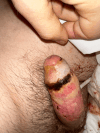Bullous Ischemic Necrosis of the Penile Shaft With Periurethral Sparing: A Novel Cutaneous Manifestation of Trazodone-Induced Priapism
- PMID: 40476099
- PMCID: PMC12139464
- DOI: 10.7759/cureus.83571
Bullous Ischemic Necrosis of the Penile Shaft With Periurethral Sparing: A Novel Cutaneous Manifestation of Trazodone-Induced Priapism
Abstract
Priapism is associated with hematologic disorders such as sickle cell disease and a rare adverse effect of psychotropic medications, including trazodone. While full-thickness penile gangrene is a rare but recognized complication of prolonged ischemic priapism, other cutaneous complications have not been described. We present an unprecedented case of a 40-year-old male who developed vesiculobullous necrosis with distinctive periurethral sparing following trazodone-induced priapism. The patient presented with a 15-hour priapism requiring surgical intervention with a modified proximal shunt, followed by the development of tense bullae on the penile shaft 48 hours after the procedure. We propose that this atypical morphology and distribution reflects distinctive features of the vascular anatomy of the penis, where the glans and periurethral tissues receive redundant blood supply from the terminal branches of the internal pudendal artery, while the shaft skin depends on superficial vessels vulnerable to compression during elevated intracavernosal pressures. The 48-hour delay between intervention and vesiculation is consistent with ischemia-reperfusion injury, a mechanism involving oxidative damage and inflammation triggered by the restoration of blood flow to ischemic tissues. This case represents a novel cutaneous manifestation of drug-induced priapism that clinicians should distinguish from other vesiculobullous disorders. Recognition of the characteristic distribution may permit clinical diagnosis without the need for biopsy, allowing for appropriate conservative management.
Keywords: bullous ischemic necrosis; ischemic priapism; medical treatment of ischemic priapism; priapism refractory to treatment; recurrent priapism; trazodone; trazodone-induced priapism.
Copyright © 2025, Gao et al.
Conflict of interest statement
Human subjects: Consent for treatment and open access publication was obtained or waived by all participants in this study. Conflicts of interest: In compliance with the ICMJE uniform disclosure form, all authors declare the following: Payment/services info: All authors have declared that no financial support was received from any organization for the submitted work. Financial relationships: All authors have declared that they have no financial relationships at present or within the previous three years with any organizations that might have an interest in the submitted work. Other relationships: All authors have declared that there are no other relationships or activities that could appear to have influenced the submitted work.
Figures


Similar articles
-
Stuttering Priapism.2024 Jan 9. In: StatPearls [Internet]. Treasure Island (FL): StatPearls Publishing; 2025 Jan–. 2024 Jan 9. In: StatPearls [Internet]. Treasure Island (FL): StatPearls Publishing; 2025 Jan–. PMID: 34662031 Free Books & Documents.
-
[Refractory ischemic priapism due to trazodone].Rev Med Liege. 2023 Jan;78(1):4-6. Rev Med Liege. 2023. PMID: 36634058 French.
-
Penoscrotal Decompression-Promising New Treatment Paradigm for Refractory Ischemic Priapism.J Sex Med. 2018 May;15(5):797-802. doi: 10.1016/j.jsxm.2018.02.010. Epub 2018 Mar 14. J Sex Med. 2018. PMID: 29550463
-
A Systematic Review on Ischemic Priapism and Immediate Implantation: Do We Need More Data?Sex Med Rev. 2019 Jul;7(3):530-534. doi: 10.1016/j.sxmr.2018.10.007. Epub 2019 Mar 19. Sex Med Rev. 2019. PMID: 30898595
-
Priapism.Int J Impot Res. 2000 Oct;12 Suppl 4:S133-9. doi: 10.1038/sj.ijir.3900592. Int J Impot Res. 2000. PMID: 11035401 Review.
References
-
- Priapism as a complication of sickle cell disease. Hamre MR, Harmon EP, Kirkpatrick DV, Stern MJ, Humbert JR. J Urol. 1991;145:1–5. - PubMed
-
- Priapism induced by various psychotropics: a case series. Greiner T, Schneider M, Regente J, Toto S, Bleich S, Grohmann R, Heinze M. https://doi.org/10.1080/15622975.2018.1520396. World J Biol Psychiatry. 2019;20:505–512. - PubMed
-
- Priapism and penile gangrene due to thrombotic thrombocytopenic purpura. Kwok B, Varol C. https://doi.org/10.1016/j.urology.2009.04.036. Urology. 2010;75:71–72. - PubMed
-
- Priapism with penile gangrene: an unusual presentation of multiple myeloma. Panwar VK, Mavuduru RS, Devana SK, Vaiphei K, Bora GS. https://doi.org/10.4103/iju.IJU_41_17. Indian J Urol. 2017;33:251–252. - PMC - PubMed
Publication types
LinkOut - more resources
Full Text Sources
